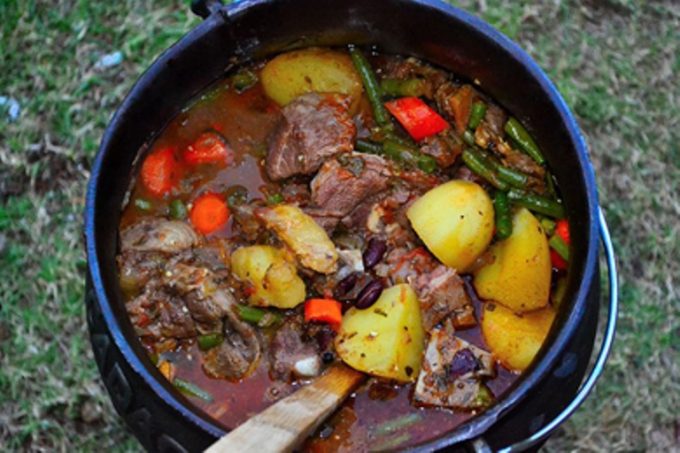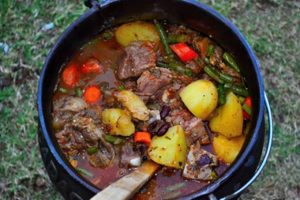How to Make Potjiekos
How to Make Potjiekos Background:
“potjiekos” is a typical South African Afrikaner meal. It was created by the Voortrekkers in the 1800s, and South Africans still prepare and eat it frequently today. There are not many “rules” to this straightforward recipe, but there are countless variations. When done correctly, a “potjie” almost prepares itself and requires little to no attention. As a result, you have more time to spend with your friends and family while the food is being prepared. potjiekos, which can be translated as “Small Pot” (potjie) and “Food” (kos), is not a stew and is not made in the same way.
FAQs: Potjiekos Recipe,
Potjiekos Recipes Beef,
Potjiekos Pronunciation,
Namibian Potjiekos Recipe,
Winning Potjie Recipes,
Potjie Recipe Book,
Pronounced:
In the International Phonetic Alphabet (IPA) “potjiekos” is pronounced poiki: kos however for those of us who do not know IPA here is a layman’s pronunciation explanation. ItsP for pig followed by KOI without the K, then K then TOSS without the T so all together it should bePOI-KEY-KOSS, “potjiekos”.
The Structure:
When “potjiekos” is prepared it is referred to as building the “potjie” in Afrikaans. The dish is normally prepared in layers and never stirred once the lid is put on. The first layer is normally that of meat. The meat can be seafood, poultry, pork, game, red meat, anything really. Next would normally be the vegetables, then the starch, and lastly the sauce would be added. Ingredients that need to cook longer are very often placed closer to the bottom of the “potjie”. Sticking to the meat, vegetables, and starch tradition works very well if you have enough liquid in the “potjie” and cook it for 2 -3 hours. Everything should then be wonderfully soft, tender, and juicy. The difference between a “potjie” and a stew is that a “potjie” is never stirred during the cooking process! Once you have built your “potjie” and put on the lid, you will not lift it again unless it is to serve up the dish. In rare cases, and usually only when you suspect something has gone wrong, will you lift the lid and peer into the “potjie”. In such cases, it normally is because the “potjie” is running dry and more liquid needs to be added. This is then poured down the sides on the inside of the “potjie” and never in the middle.
The Science and Procedure:
Cooking oil is heated in a pot, usually of cast iron, until very hot. Meat and normally onions as well are then browned by searing them in the oil. This locks in the juiciness of the meat. The meat is not cooked until down, just seared and browned. Vegetables are then packed in layers on top of the meat spreading each kind evenly throughout the dish. It is ‘sealed’ with starch traditionally potatoes are cut in slices but it can be pasta, rice, or anything else. This traps the steam around the vegetables and actually steam cooks them. “potjiekos” is cooked slowly over a moderate heat source. Traditionally this would be done outdoors over coals but today can be done anywhere over any heat source. The dish is slow-cooked and the way it is built creates a small pressure cooker effect because the cast iron lids are heavy. The steam build-up inside has to become substantial before it starts to leak past the lid.
The Art:
Champion “potjiekos” cooks prepare their dish in layers, with meat at the bottom, then vegetables, and then the starch. They then put the lid on and do not lift it again until the dish is done. Cooks would listen to the slight bubbling and simmering of the “potjie” by holding an ear close to the lid. This is called listening to the “potjie” talk. The cook listens and then controls the heat at the bottom of the “potjie”. While holding an ear close to the side of the lid, (be careful not to let escaping steam burn you) the cook should hear a slight bubbling with a bubble every second or two. A rapidly boiling “potjie” is a recipe for disaster. What you should hear is a slight bubble as if the food is simmering. You should never hear something boiling or rapidly bubbling as “potjiekos” is prepared slowly over moderate heat. Adjust the heat source until you hear the desired sound. Remember that it takes a few minutes, sometimes up to 10, before the “potjie” will respond to heat adjustment.
Fun Fact: This entire demonstration, photos, and videos, was captured with my Samsung Galaxy S cellphone.
Utensils:
A heat source. (Traditionally a fire is prepared outside on the ground. Once coals have formed the fire is split in two. A few coals are for the “potjie” and the other is kept going in case more coals are needed later. Nowadays gas is often used as I have in this demonstration.)
A “potjie”. (Traditionally it would be a three-legged cast iron pot but frequently is flat-bottomed. The cast iron is needed because you need a heavy lid to create a slight pressure cooker effect inside the pot but you could actually use a normal pot as well. )
A spoon
Potjiekos Ingredients:
I used the following in this “potjie”
50 ml cooking oil
250g carrots
250g cauliflower
500g beef, diced
450 – 550 ml of sauce (I bought an off-the-self packet because I was too lazy to capture that as well)
Wash everything thoroughly with soap and water before you start cooking, including your hands, as you probably will be handling some of the food. Normal hygiene rules apply when working with food so stick to them.
Today’s “potjie” is not ‘traditional’ in the sense that we will not be using an open fire, outside on the ground nor will we be using traditional ingredients like game meat (“wildsvleis” in Afrikaans). We will however be using the traditional method with ingredients that should be readily available anywhere in the world.
NOTE: There is nothing more traditional than serving a delicious potjie at your next social event! “potjiekos” is a traditional South African Afrikaner stew that is cooked over a fire in a three-legged cast-iron pot.” The difference between a “potjie” and a stew is that a “potjie” is never stirred during the cooking process and is always cooked slowly over hot coals in a cast iron pan.
#Potjiekos #potjie #Afrikaner







